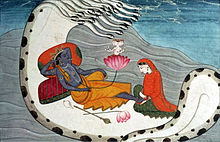Nagalakshmi
| Nagalakshmi | |
|---|---|
Queen of the Serpents[1] | |
| Affiliation | Vaishnavism |
| Abode | Vaikuntha |
| Texts | Garga Samhita |
| Genealogy | |
| Spouse | Shesha |
| Part of a series on |
| Vaishnavism |
|---|
 |
Nagalakshmi (Sanskrit: नागलक्ष्मी, romanized: nāgalakṣmī) is a serpent goddess and the consort of Shesha, a nagaraja (king of the serpents) and one of the two mounts of Vishnu featured in Hindu mythology. She is considered to be the personification of the divine ocean called the Kshira Sagara.[2]
Legend
[edit]
Nagalakshmi's legend is mainly found in the Garga Samhita. In this, the Kshira Sagara is personified as her. In Chapter 3 of the Balabhadra Khanda of the Garga Samhita, it is mentioned that she incarnated on earth along with her husband.[3][4]
The Kshira Sagara is the fifth from the centre of the seven oceans. It surrounds the continent known as Krauncha.[5] According to Hindu scriptures, the devas and asuras worked together for a millennium to churn this ocean in order to acquire amrita, the elixir of immortal life.[6] It is described as the place where the deity Vishnu reclines over his serpent-mount Shesha, accompanied by his consort, Lakshmi.[7]
Incarnations
[edit]
In the Treta Yuga, she incarnated as Urmila, the wife of Lakshmana. She was born as the daughter of King Janaka of Mithila and Queen Sunayana. She played a prominent role in the Hindu epic Ramayana.[8][9] When Shesha's avatar Lakshmana went to exile with Rama (Vishnu's avatar), Urmila slept continuously for fourteen years so that her husband could serve his brother without requiring sleep, an episode known as Urmila Nidra.[10][11]

In the Dvapara Yuga, she was born as Revati, the wife of Balarama and the daughter of King Kakudmi of Kushasthali.[12] However, in traditions where Balarama is identified with Vishnu, Revati is regarded to be a form of Lakshmi.[13]
Literature
[edit]In the Garga Samhita, the sage Pradipika recounts the attributes of Nagalakshmi:[14]
Following this, the radiant Nagalakshmi, glowing with the brilliance of countless autumn moons, arrived on a magnificent chariot, accompanied by millions of her companions whose radiance was ever-increasing. She approached the great Sankarshana and expressed her desire, Lord, I also wish to accompany you on Earth. The thought of being separated from you would afflict me so deeply that I wouldn't be able to bear it. Nagalakshmi was overwhelmed with emotion.
Lord Ananta (Shesha), who is the ultimate cause behind all causes in the entire universe, whose very nature is to alleviate the sorrows of devotees, and whose divine form resembles the great serpent Airavata, comforted his beloved. He said, O Rambhoru! Do not grieve. Descend to Earth and merge with the body of Revati. There, you will serve me.
Upon hearing this, Nagalakshmi inquired, Who is Revati? Whose daughter is she, and where does she reside? Please tell me in detail. Hearing this, Lord Ananta, with a smile, explained, It is the story of the beginning of creation. I, born as the son of the sage Kashyapa from Kadru's womb, took a formidable form.
— Garga Samhita, Chapter 3
Worship
[edit]The Ananthankavu Nagalakshmi Temple, located in Thiruvananthapuram, Kerala, is known for its environmental sensitivity and association with snakes. It stands as the sole sacred grove (surppakavu) housing ancient 1000-year-old idols of Nagalakshmi and Nagaraja Ananthan.[15]
References
[edit]- ^ Handa, Om Chanda (2004), Naga Cults and Traditions in the Western Himalaya, Indus Publishing, ISBN 978-8173871610
- ^ Garga Saṁhita. Rasbihari Lal & Sons. 2006. ISBN 978-81-87812-98-2.
- ^ Raj, Selva J.; Dempsey, Corinne G. (12 January 2010). Sacred Play: Ritual Levity and Humor in South Asian Religions. State University of New York Press. ISBN 978-1-4384-2981-6.
- ^ Śrīgargasaṃhitā: Kīrtibhāṣāsārasahitā (in Sanskrit). Vyāsa Bālābakṣa Śodhasaṃsthāna. 2000.
- ^ D. Dennis Hudson: The body of God: an emperor's palace for Krishna in eighth-century Kanchipuram, Oxford University Press US, 2008, ISBN 978-0-19-536922-9, pp.164-168
- ^ "Churning the Ocean of Milk by Michael Buckley".
- ^ Jones, Constance; Ryan, James D. (2006). Encyclopedia of Hinduism. Infobase Publishing. p. 288. ISBN 978-0-8160-7564-5.
- ^ Praśānta Guptā (1998). Vālmīkī Rāmāyaṇa. Dreamland Publications. p. 32. ISBN 9788173012549.
- ^ MacFie, J. M. (1 May 2004). The Ramayan Of Tulsidas Or The Bible Of Northern India. Kessinger Publishing. ISBN 978-1-4179-1498-2.
- ^ Reeja Radhakrishnan (28 March 2014). "Urmila, The Sleeping Princess". Indian Express. Chennai. Archived from the original on 25 June 2016. Retrieved 1 June 2016.
- ^ "Sleeping beauty: The unsung sacrifice of Urmila". The Hindu. Retrieved 29 November 2023.
- ^ Dalal, Roshen (2014-04-18). Hinduism: An Alphabetical Guide. Penguin UK. ISBN 978-81-8475-277-9.
- ^ Gupta, Sanjukta (1972-01-01). LAKSMI TANTRA. Brill Archive. p. 47.
- ^ Swami, HH Lokanath (20 August 2020). व्रजमण्डल दर्शन: तीस दिवसीय परिक्रमा के अनुभव (in Hindi). Padayatra Press. ISBN 978-93-5267-307-0.
- ^ "Ananthankavu Naga Lakshmi Temple". Holy Prasadam.
